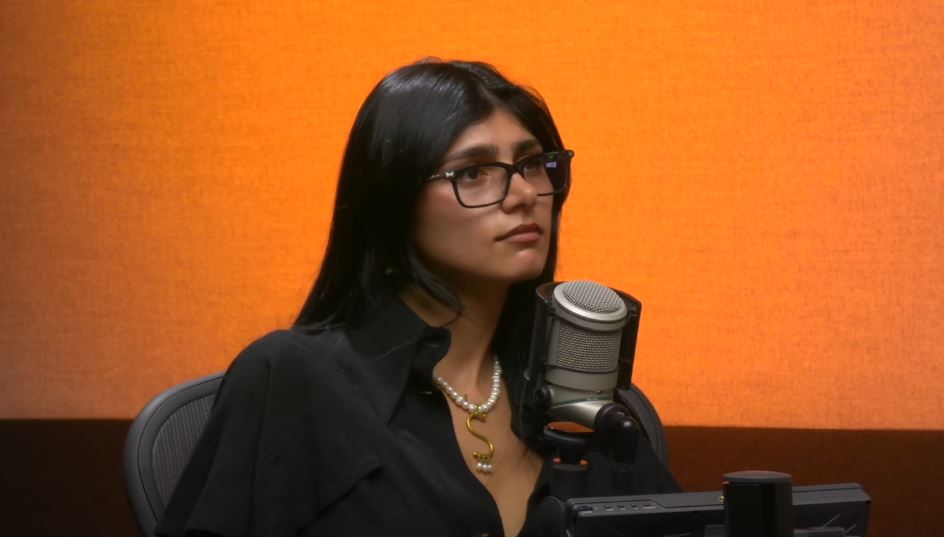
Despite being one of her generation’s most well-known figures, Mia Khalifa is still a financial mystery to many. Despite having a remarkably short career in adult entertainment—only three months, according to reports—her impact lasted much longer, radically altering online debates regarding reputation, image rights, and ownership. Despite being misinterpreted by many, her post-industry journey has been characterized by strategic reinvention and a financial trajectory that diverges significantly from the story that many associate with her.
Khalifa gained notoriety during her 2014 adult film career after a contentious scene involving a hijab provoked online indignation and international condemnation. Although emotionally draining, the backlash unintentionally thrust her into a level of notoriety that few names in the industry attain so quickly. She has made it clear time and time again that she only made $12,000 overall from her work in adult films, a figure that many people still erroneously believe to be her current income.
Mia Khalifa Bio & Career Overview
| Attribute | Details |
|---|---|
| Full Name | Sarah Joe Chamoun |
| Stage Name | Mia Khalifa |
| Date of Birth | February 10, 1993 |
| Age | 32 |
| Birthplace | Beirut, Lebanon |
| Nationality | Lebanese-American |
| Education | Bachelor’s in History, University of Texas at El Paso |
| Career Start | 2014 (Adult Entertainment) |
| Transitioned To | Sports commentary, social media, business ventures |
| Current Roles | Influencer, content creator, OnlyFans model, jewelry entrepreneur |
| Estimated Net Worth | $8 to $20 million (as of 2025) |
| Key Income Sources | OnlyFans, brand endorsements, merchandise, social media deals |
| Notable Backlash | 2014 adult video involving hijab triggered global controversy |
Khalifa started rewriting her public image by deliberately removing herself from that chapter. She started a rebranding campaign through strategic alliances that did a great job of changing her reputation. Notably, she developed an incredibly genuine bond with fans by focusing on sports commentary, particularly on college football and the NHL. This change in direction was incredibly successful in making her more relevant than the shock value of her past.
She has made money from her enormous social media following over the last five years through platform partnerships, targeted brand deals, and—most profitably—OnlyFans. Khalifa has been able to regain control over her content, pricing, and audience relationship thanks to OnlyFans, in contrast to traditional adult platforms. She reportedly makes between five and six figures a month, which is especially remarkable considering her prior disassociation from explicit film work. She has created a subscription-based ecosystem that is incredibly resilient and self-sufficient by utilizing this model.
Depending on the source, her current estimated net worth varies between $8 and $20 million. The decentralized nature of her income and the absence of publicly disclosed assets are partially to blame for this fluctuation. Partial disclosures and anecdotal evidence, however, point to strong revenue streams. Notably, Sheytan, her jewelry brand, has added another commercial pillar. It is especially creative in the way it combines modern streetwear trends with Middle Eastern aesthetics.
She has maintained her commercial relevance by working with other influencers, planning launches strategically, and having a distinct vision for her personal brand. Khalifa has proven to have a very effective monetization model, which enables her to change course without relying on institutions or gatekeepers in a time when social currency can be converted directly into income.
By 2025, Mia Khalifa had significantly enhanced her public image in addition to diversifying her revenue. Her followers have responded sympathetically to her candor about trauma, cyberbullying, and industry apologies. Despite the risks, this emotional transparency has been especially helpful in presenting her current projects in a humane manner as opposed to tabloid sensationalism.
She increased her online presence during the pandemic by engaging with her followers more frequently, hosting Q&A sessions, and tackling unresolved issues. In a culture where influencers are everywhere, her ability to control the narrative has made her incredibly dependable to fans looking for authenticity. Khalifa creates content that feels surprisingly affordable yet deeply personal, a duality rarely accomplished at her scale, in contrast to many who merely ride viral waves.
She expertly customizes offerings by utilizing audience engagement data and sophisticated social analytics, guaranteeing a harmony between follower loyalty and brand value. When compared to her early career decisions, which were frequently made on the spur of the moment and without advice, such execution highlights her noticeably improved business acumen.
Her influence is anticipated to grow in the upcoming years into digital media ownership, mainstream fashion, and possibly scripted entertainment. Her story is a powerful illustration of what happens when someone takes back control of their story: turning fame into power and power into money.
Khalifa has increased her digital capital in addition to preserving it through strategic alliances and well-timed exits. Public scrutiny and legal battles over her past have sharpened her resilience, which is now driving a business model that others are starting to imitate. What appeared to be a minor detail in adult entertainment has subtly transformed into a multifaceted personal brand model, especially inventive in its fusion of vulnerability and business.
Her journey offers something especially helpful to many creators going through similar changes: evidence that fame, when combined with deliberate development, can turn into a surprisingly stable source of income. In contrast, Mia Khalifa’s present is much more focused, faster-paced, and financially optimized than her past.
